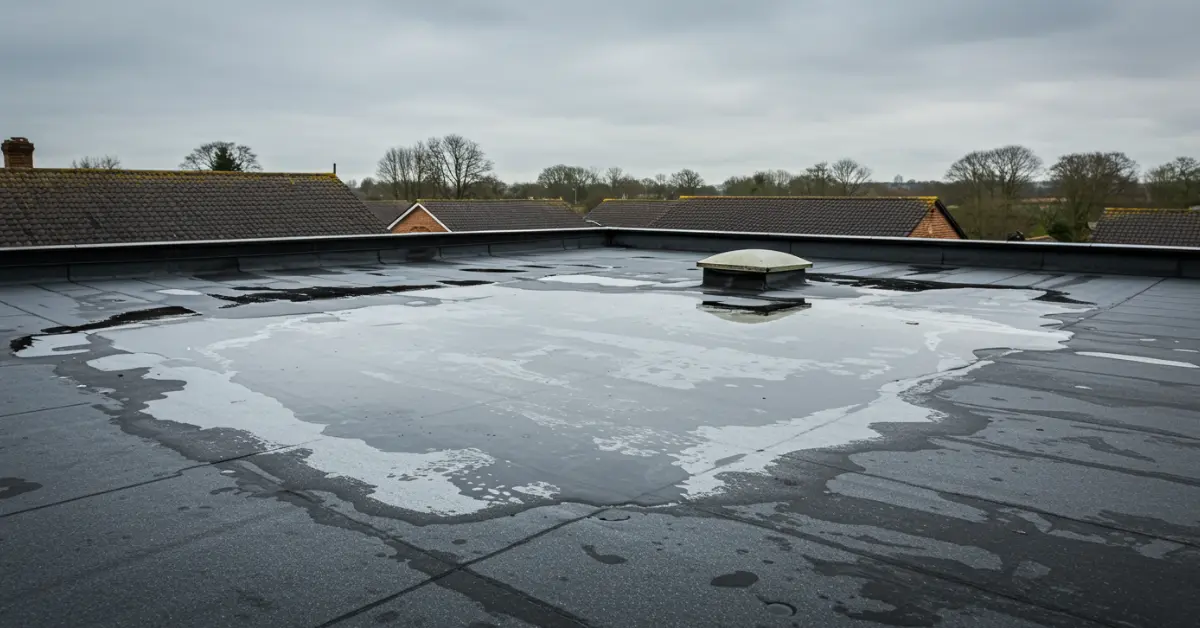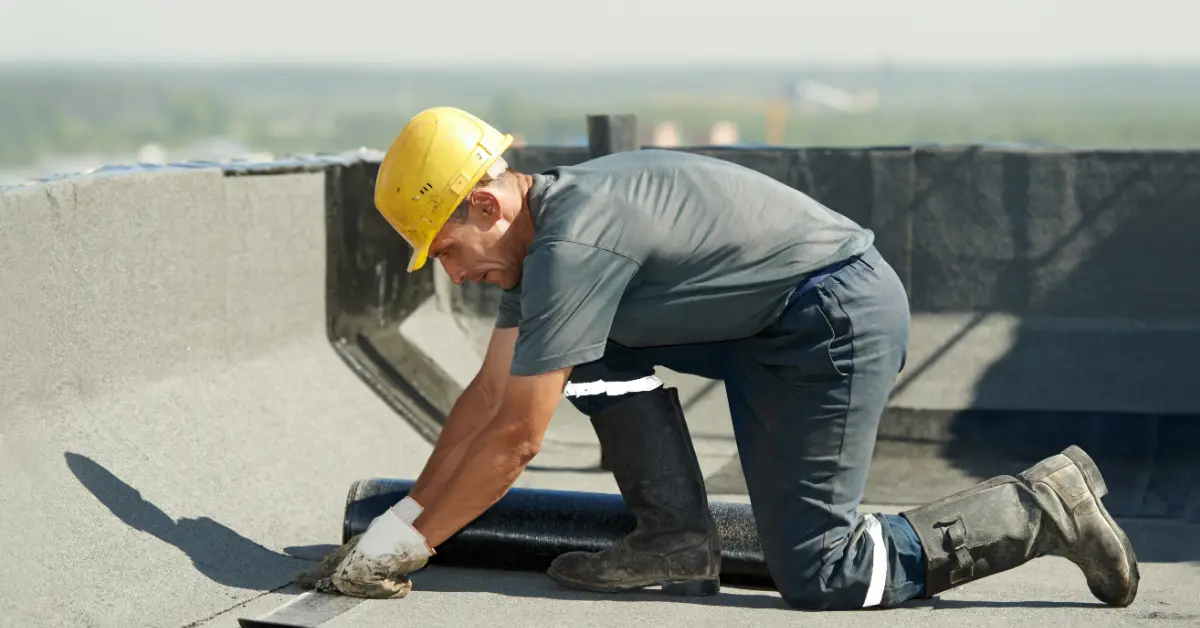Common Flat Roof Problems can affect any Lewisham home with a flat roof if left unchecked. Flat roofs are popular on modern homes, garages, and extensions, thanks to their sleek design and space-saving features. But like any roof, flat roofs come with their own flat roof problems that, if ignored, can quickly escalate into costly repairs. Understanding these issues early makes sure your home stays safe, dry, and structurally sound.
Think about it: a small puddle on your flat roof today could become flat roof leaks in heavy rain tomorrow. By learning what to look for and taking quick action, you can prevent minor issues from turning into serious roof problems. Let’s explore the most common flat roof issues, why they matter, and how to avoid them.
Common Flat Roof Problems

To keep your flat roof safe, it’s important to understand the challenges it faces. Here are the problems that happen most often:
1. Poor Drainage and Water Pooling
Flat roofs don’t naturally shed water like pitched roofs. In your city, heavy rain can quickly turn a seemingly harmless roof into a pool of standing water. If drains are blocked or the roof slope is poorly designed, water can linger for days. This standing water slowly penetrates roofing materials, leading to mould, weakened insulation, and eventually leaks. Left untreated, it can escalate into costly repairs and compromise the structure of your home. After any significant rainfall, inspect your roof for puddles. If water remains for longer than a day or two, contact a trusted roofing professional immediately to prevent the damage from spreading.
2. Leaks and Moisture Penetration
Leaks can start small, sneaking in through cracks, unsealed seams, or worn-out membranes. Often, the first signs appear inside your home as damp patches, peeling paint, or water stains on ceilings. By the time you notice them, the moisture may have already damaged insulation, wooden structures, or interior walls. Regular inspections, especially after storms, are crucial for maintaining safety and preventing damage. If you’re wondering what to look for, here’s a helpful guide on detecting roof leaks early that can save you from bigger problems later. Catching leaks early not only saves money but also prevents structural issues that can become a major headache.
3. Cracks and Surface Deterioration
Flat roofs often face extreme weather conditions, including scorching sun, heavy rain, strong winds, and freezing nights. Over time, these elements cause the roofing material to crack, blister, or peel. Even small cracks can allow water to penetrate beneath the surface, leading to deterioration and leaks. In Lewisham’s variable climate, regular surface checks are essential. Quick patching at the first sign of damage can extend the life of your roof and prevent more extensive and expensive repairs.
4. Poor Installation and Design Flaws
Not all flat roofs are created equal. A roof installed without attention to proper slope, quality materials, or correct seam sealing is vulnerable from the moment it is installed. Weak installation leads to early membrane failures, leaks, and uneven water pooling. Even a new roof can underperform if the installation was rushed or poorly executed. Hiring experienced roofing contractors makes sure the job is done right and helps you avoid recurring issues. A well-installed flat roof can last decades, while a poorly done one can be a constant source of stress.
Not all flat roofs are created equal. A roof installed without attention to proper slope, quality materials, or correct seam sealing is vulnerable from the moment it is installed. Weak installation leads to early membrane failures, leaks, and uneven water pooling. Even a new roof can underperform if the installation was rushed or poorly executed. Hiring experienced roofing contractors makes sure the job is done right and helps you avoid recurring issues. A well-installed flat roof can last decades, while a poorly done one can be a constant source of stress.
5. Ponding Water and Structural Damage
Repeated ponding of water is more than an aesthetic problem. The extra weight strains the roof’s structure, which may cause sagging, cracks in supporting beams, or damage to the roof deck. Structural issues not only affect the roof but can also compromise safety inside your home. Maintaining proper drainage and slopes, along with periodic inspections, prevents ponding and protects both your roof and the living spaces beneath it.
6. Roof Membrane Problems
Most flat roofs rely on a waterproof membrane, such as EPDM, PVC, or bitumen, to protect against water. Over time, these membranes may shrink, crack, or tear due to exposure to weather conditions. A damaged membrane leaves your roof vulnerable to leaks, dampness, and mould. Look out for bubbles, peeling edges, or visible cracks. Repairing minor issues promptly can save significant expense later. For more on choosing durable roofing membranes, visit this guide to flat roof materials.
7. Blocked or Clogged Gutters and Drains
Leaves, twigs, and debris can quickly clog gutters and drains. Blockages stop water from draining, creating overflow that can seep into the roof or walls. Regular gutter cleaning, particularly in autumn when leaves fall, is one of the easiest ways to protect your flat roof and prevent leaks. A small effort now avoids expensive damage later.
8. Moss, Algae, and Vegetation Growth
Flat roofs are prone to retaining moisture, making them ideal environments for moss, algae, and other vegetation. Moss growth not only looks unsightly but also causes cracks in roofing materials as its roots penetrate the surface. Algae and lichen can degrade membranes, reduce water flow, and contribute to damp patches in indoor environments. Routine cleaning and moss treatment prolong the roof’s lifespan and preserve its waterproof integrity.
9. UV Damage and Heat Stress
In addition to rain and moisture issues, flat roofs face the effects of sunlight and heat. Continuous exposure to UV rays can cause membranes to become brittle, fade, or develop tiny cracks that compromise waterproofing. Heat stress also accelerates material ageing, particularly on dark membranes that absorb more sunlight. Over time, this exposure can lead to leaks, blistering, or even structural damage if left unaddressed. To protect your roof, consider applying UV-resistant coatings or reflective layers that reduce heat absorption.
Tips to Prevent Flat Roof Problems

- Inspect your roof twice a year and after storms.
- Keep gutters and drains clear of debris.
- Sweep off leaves, dirt, and moss on a regular basis.
- Seal small cracks as soon as you notice them.
Always choose experienced roofers in Lewisham for repairs and installations. Good workmanship helps your flat roof last longer and saves you money in the long run.
Conclusion
Your flat roof can either be a reliable shield over your home or a constant source of stress, and the difference comes down to care. A small crack, puddle, or blocked drain may not seem urgent today, but left unattended, it can develop into a costly repair tomorrow.
By checking your roof regularly, fixing problems early, and relying on trusted roofing services in Lewisham, you’re not just protecting your home from common flat roof problems. Still, you’re protecting your peace of mind. Don’t wait until a leak forces you to act. Take control now and enjoy a safe, stylish, and worry-free home for years to come.
FAQs
1. What is the most common defect in a flat roof?
Poor drainage, resulting in water pooling, is one of the most common issues with flat roofs. If left untreated, it can lead to leaks and structural damage.
2. What is the longest-lasting flat roof material?
EPDM rubber roofing is considered one of the most durable, lasting 25 to 30 years with proper care.
3. What is the best waterproofing for a flat roof?
Liquid-applied membranes and high-quality bitumen systems offer excellent waterproofing when properly installed.
4. How often should I check my flat roof?
At least twice a year, and after heavy rain or storms.
5. Do flat roofs always leak?
Not at all. When installed and properly cared for, they can be just as reliable as pitched roofs.

